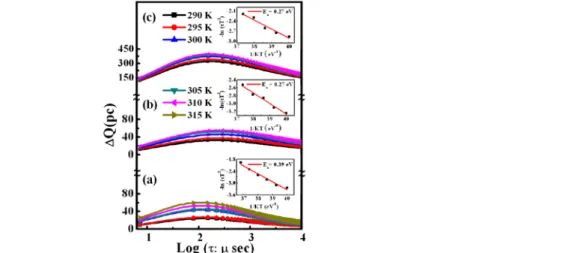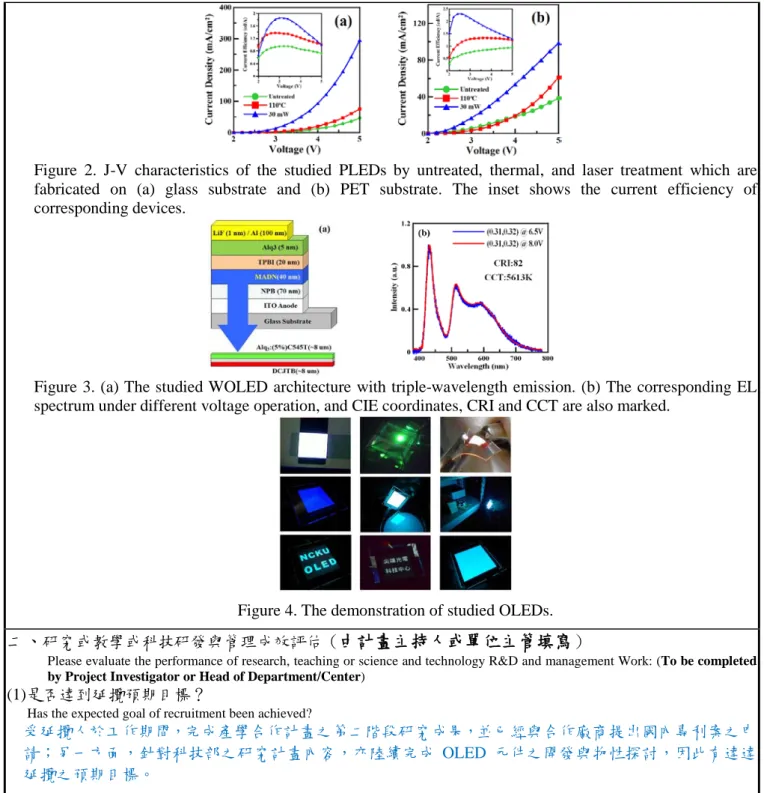應用於植物工廠OLED光源之開發
4
0
0
全文
(2) Burroughes et al. reported on the first PLED in 1990, much effort has been made to improve the performance of MEH-PPV-based PLEDs. Liu et al. studied on dependence of the morphology of MEH-PPV films on the process parameters, including solvents and spin-conditions. Many groups have incorporated polyhedral oligomeric silsesquioxane (POSS) into the polymer backbones by a chemical procedure or physical blending which reduce molecular aggregation (or excimer formation), to improve the electroluminescence (EL) performance of polymer films. Aromatic 1,3,4-oxadiazole-based compounds, which have high electron affinity, have been blended with conjugated emissive polymers to improve the injection of electrons, the transport properties and therefore the EL performance of PLEDs. Recently, doping with inorganic quantum dots, such as cadmium selenide (CdSe) and copper indium disulfide (CuInS2), has been found to be an effective approach to improving the performance of MEH-PPV-based PLEDs. As well as the aforementioned strategies, thermal annealing has been commonly used to modify of MEH-PPV films and consequently to improve the performance of PLEDs. Annealing treatment prior to the deposition (or pre-deposition) of an Al cathode produces a PLED with a high luminescence output because it enhances the thermal stability of an MEH-PPV film. In the literature, the injection of electrons, which reduces the operating voltage of the PLED by increasing interfacial adhesion is also enhanced. A major problem concerning thermal-treatment of a PLED is the increase in interchain interaction which leads to formation of excimers and reduces the EL efficiency of PLED. This studies the effects of laser annealing, which has been used to modify other organic molecules, on MEH-PPV film and MEH-PPV-based PLEDs. The photoluminescence spectra and surface roughness of polymer films that were treated by thermal annealing and laser annealing are further compared herein, with reference to temperature, laser power, and period of treatment. (4) 首度提出使用分離式色轉換層來製作白光OLED元件 White organic light-emitting diodes (WOLEDs) have attracted considerable interest owing to its potential application in backlight of flat panel display and solid-state lighting since the first reported in 1995. The milestone of WOLEDs as practice lighting source was marked by S. Reineke et al. who reported the phosphor-based WOLED exhibited the comparable power efficiency with fluorescent tube, in which 90 lm/W at 1,000 cd/m2 was realized. The device architecture consisting of single emissive layer or stacked multi-emissive layers are two of commonly used to produce white emission. Nevertheless, the former has poor yield rate when it comes to deposit more than two dopants in single emissive layer, and the chromatic stability would be a crucial problem owing to different operation voltage/current in the latter. An alternative approach to generate white emission utilizing single blue-emission OLED couples with color down-conversion layers (CCLs) was first reported by A. R. Duggal et al. To date, the WOLEDs based on CCLs architecture with high efficiency, color rendering index (CRI), and chromatic stability have been demonstrated. In this work, we first reported a simple WOLED architecture based on blue-emission OLED with a separated CCL, which provides the advantages of short process time, color tunable, and stable fabrication yield, compared to conventional WOLEDs employing CCL.. Figure 1. Q-DLTS spectra of the NPB layers (a) without doping, (b) with 1 wt% doping, and (c) with 10 wt% doping. The insets show the Arrhenius plots for determining the Ea values.. 2.
(3) Figure 2. J-V characteristics of the studied PLEDs by untreated, thermal, and laser treatment which are fabricated on (a) glass substrate and (b) PET substrate. The inset shows the current efficiency of corresponding devices.. Figure 3. (a) The studied WOLED architecture with triple-wavelength emission. (b) The corresponding EL spectrum under different voltage operation, and CIE coordinates, CRI and CCT are also marked.. Figure 4. The demonstration of studied OLEDs.. 二、研究或教學或科技研發與管理成效評估(由計畫主持人或單位主管填寫) Please evaluate the performance of research, teaching or science and technology R&D and management Work: (To be completed by Project Investigator or Head of Department/Center). (1)是否達到延攬預期目標? Has the expected goal of recruitment been achieved?. 受延攬人於工作期間,完成產學合作計畫之第二階段研究成果,並已經與合作廠商提出國內專利案之申 請;另一方面,針對科技部之研究計畫內容,亦陸續完成 OLED 元件之開發與物性探討,因此有達達 延攬之預期目標。 (2)研究或教學或科技研發與管理的方法、專業知識及進度如何? What are the methods, professional knowledge, and progress of the research, teaching, or R&D and management work?. 受延攬人藉由對於有機發光元件之製作經驗與技術,包括高真空蒸鍍設備之操作、元件圖樣之設計,以 及元件薄膜厚度之調整等,已達到產學合作計畫所規劃之初步計畫目標,同時將其相關研究成果提交國 內專利案之申請。另一方面,受延攬人依據實驗機台所做的改良設計,製作出大型發光面積之 OLED 元件,對於後續之計畫執行或是實務之應用上皆可提供重要的基礎研究。 (3)受延攬人之研究或教學或科技研發與管理成果對該計畫(或貴單位)助益如何? How have the research, teaching, or R&D and management results of the employed person given benefit to the project (or your unit)?. 受延攬人於工作期間陸續完成有機白光元件以及大型發光面積 OLED 元件之製作,其中前者之研究成 果亦已提出國內專利案之申請,對於計畫所衍生之應用價值將有所助益。另一方面,受延攬人所開發出 之大面積 OLED 元件,對於該研究計畫之未來規劃將提供重要的參考依據。 (4)受延攬人於補助期間對貴單位或國內相關學術科技領域助益如何? How has the employed person, during his or her term of employment, benefited your unit or the relevant domestic academic field?. 受延攬人與產學合作廠商共同開發出以簡易製程來製作有機白光元件,依據其實驗成果,已經可以獲 得具有理想色度表現之白光元件。對於國內外有機白光元件之應用市場,包括顯示器之背光源或是室 3.
(4) 內照明等,其計畫之研究成果可以提供一重要參考依據,並可整合高效率材料之開發,進而改善有機 白光元件之特性表現。另一方面,受延攬人於下一聘期將接續多重波段 OLED 元件之製作技術,並進 一步將其應用於植物栽培之光源,對於目前已逐漸受到重視之植物工廠,在人工光源之開發上預期能 夠提供重要參考價值。 (5)具體工作績效或研究或教學或科技研發與管理成果: Please describe the specific work performance, or the results of research, teaching, or R&D and management work:. 受延攬人於工作期間,完成產學合作計畫之第二期計畫目標,並將其研究成果提出國內專利案之申請; 同時於科技部研究計畫案中,已陸續完成 OLED 元件之技術開發與物性探討以及進一步將 OLED 元件 技術應用於植物栽培之光源。 (6)是否續聘受聘人? Will you continue hiring the employed person? □續聘 Yes ■不續聘 No. ※ 此報告表篇幅以三~四頁為原則。This report form should be limited to 3-4 pages in principle. ※ 此表格可上延攬優秀人才成果報告繳交說明網頁下載。 This report form can be downloaded in http://scholar.lib.ncku.edu.tw/explain/. 4.
(5)
數據


相關文件
如圖,已知平行四邊形 EFGH 是平行四邊形 ABCD 的縮放圖形,則:... 阿美的房間長 3.2 公尺,寬
Health Management and Social Care In Secondary
printing, engraved roller 刻花輥筒印花 printing, flatbed screen 平板絲網印花 printing, heat transfer 熱轉移印花. printing, ink-jet
(1) Western musical terms and names of composers commonly used in the teaching of Music are included in this glossary.. (2) The Western musical terms and names of composers
[r]
4.1 Extreme Values of Functions on Closed Intervals 4.2 The Mean Value Theorem.. 4.3 Monotonic Functions and the First Derivative Test 4.4 Concavity and
年青的學生如能把體育活動融入日常生活,便可提高自己的體育活動能
常識科的長遠目標是幫助學生成為終身學習者,勇於面對未來的新挑 戰。學校和教師將會繼續推展上述短期與中期發展階段的工作